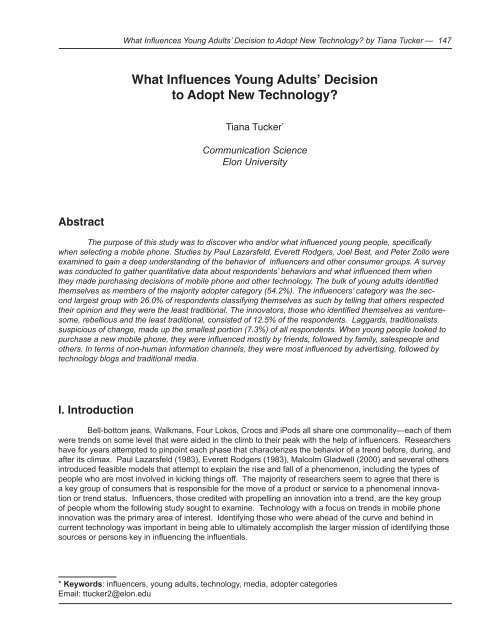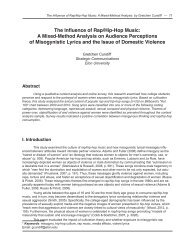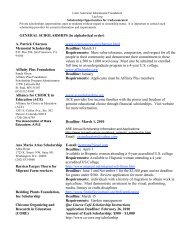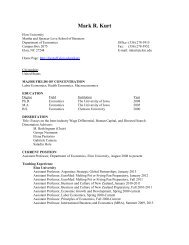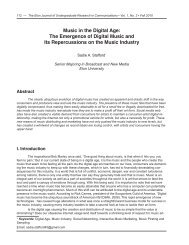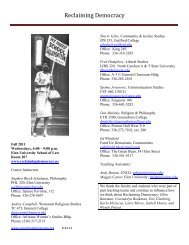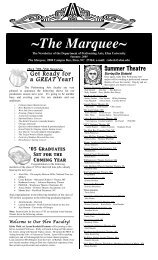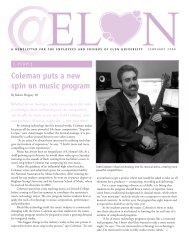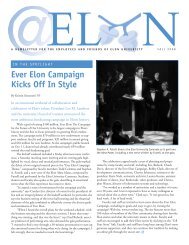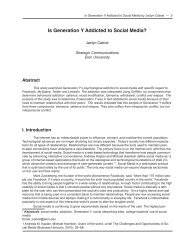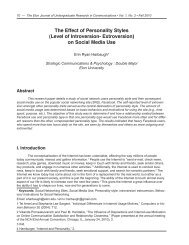What Influences Young Adults' Decision to Adopt ... - Elon University
What Influences Young Adults' Decision to Adopt ... - Elon University
What Influences Young Adults' Decision to Adopt ... - Elon University
Create successful ePaper yourself
Turn your PDF publications into a flip-book with our unique Google optimized e-Paper software.
<strong>What</strong> <strong>Influences</strong> <strong>Young</strong> Adults’ <strong>Decision</strong> <strong>to</strong> <strong>Adopt</strong> New Technology? by Tiana Tucker — 147<br />
<strong>What</strong> <strong>Influences</strong> <strong>Young</strong> Adults’ <strong>Decision</strong><br />
<strong>to</strong> <strong>Adopt</strong> New Technology?<br />
Tiana Tucker *<br />
Communication Science<br />
<strong>Elon</strong> <strong>University</strong><br />
Abstract<br />
The purpose of this study was <strong>to</strong> discover who and/or what influenced young people, specifically<br />
when selecting a mobile phone. Studies by Paul Lazarsfeld, Everett Rodgers, Joel Best, and Peter Zollo were<br />
examined <strong>to</strong> gain a deep understanding of the behavior of influencers and other consumer groups. A survey<br />
was conducted <strong>to</strong> gather quantitative data about respondents’ behaviors and what influenced them when<br />
they made purchasing decisions of mobile phone and other technology. The bulk of young adults identified<br />
themselves as members of the majority adopter category (54.2%). The influencers’ category was the second<br />
largest group with 26.0% of respondents classifying themselves as such by telling that others respected<br />
their opinion and they were the least traditional. The innova<strong>to</strong>rs, those who identified themselves as venturesome,<br />
rebellious and the least traditional, consisted of 12.5% of the respondents. Laggards, traditionalists<br />
suspicious of change, made up the smallest portion (7.3%) of all respondents. When young people looked <strong>to</strong><br />
purchase a new mobile phone, they were influenced mostly by friends, followed by family, salespeople and<br />
others. In terms of non-human information channels, they were most influenced by advertising, followed by<br />
technology blogs and traditional media.<br />
I. Introduction<br />
Bell-bot<strong>to</strong>m jeans, Walkmans, Four Lokos, Crocs and iPods all share one commonality—each of them<br />
were trends on some level that were aided in the climb <strong>to</strong> their peak with the help of influencers. Researchers<br />
have for years attempted <strong>to</strong> pinpoint each phase that characterizes the behavior of a trend before, during, and<br />
after its climax. Paul Lazarsfeld (1983), Everett Rodgers (1983), Malcolm Gladwell (2000) and several others<br />
introduced feasible models that attempt <strong>to</strong> explain the rise and fall of a phenomenon, including the types of<br />
people who are most involved in kicking things off. The majority of researchers seem <strong>to</strong> agree that there is<br />
a key group of consumers that is responsible for the move of a product or service <strong>to</strong> a phenomenal innovation<br />
or trend status. Influencers, those credited with propelling an innovation in<strong>to</strong> a trend, are the key group<br />
of people whom the following study sought <strong>to</strong> examine. Technology with a focus on trends in mobile phone<br />
innovation was the primary area of interest. Identifying those who were ahead of the curve and behind in<br />
current technology was important in being able <strong>to</strong> ultimately accomplish the larger mission of identifying those<br />
sources or persons key in influencing the influentials.<br />
* Keywords: influencers, young adults, technology, media, adopter categories<br />
Email: ttucker2@elon.edu
148 — The <strong>Elon</strong> Journal of Undergraduate Research in Communications • Vol. 2, No. 2 • Fall 2011<br />
II. Literature Review<br />
The chain that a trend climbs has varying levels depending on which researcher one decides <strong>to</strong><br />
ask, whether it is Paul Lazarsfeld (1983), Everett Rodgers (1983), Joel Best (2006) or Peter Zollo (2004). A<br />
number of researchers have created their individual models of the types of people involved in an innovation’s<br />
journey pre-trend, post-trend, and at the points in-between.<br />
Two-Step Flow Model<br />
The two-step flow model, developed by Paul Lazarsfeld, was the result of a move <strong>to</strong> discard the<br />
hypodermic needle model, in which “mass media had direct, immediate, and powerful effects on a mass<br />
audience,” (Rodgers, 1983, p. 272). Lazarsfeld’s study revealed two important pieces of information about<br />
the flow or diffusion of ideas. The first is that the transmitting of information typically happens from sources<br />
<strong>to</strong> opinion leaders. The second step is the expansion of influence from opinion leaders <strong>to</strong> potential followers<br />
(Rodgers, 1983, p. 273).<br />
Diffusion of Innovations<br />
Everett Rodgers’ Diffusion of Innovations (1983) presents a number of valid points that are foundational<br />
in the process of discovering influencers among Generation Y consumers, including the establishment<br />
of adopter categories and Lazarsfeld’s two-step flow model<br />
All of the five categories of adoption in Rodgers’ innovation model were created based on people’s<br />
varying levels of innovativeness. Innovativeness is defined as a continuous variable that measures “the degree<br />
<strong>to</strong> which an individual or other units of adoption [are] relatively earlier in adopting new ideas” (Rodgers,<br />
1983, p. 245).<br />
Fueled by a venturesome nature that propels their eagerness <strong>to</strong> try new things, innova<strong>to</strong>rs are generally<br />
the first <strong>to</strong> adopt a concept. The innova<strong>to</strong>r plays a major part in the diffusion process where the individual<br />
is a gatekeeper or one who has control over whether something is introduced in the social sphere. Innova<strong>to</strong>rs<br />
typically surround themselves with other innova<strong>to</strong>rs who seek <strong>to</strong> involve themselves in risky, rash and daring<br />
activities (Rodgers, 1983, p. 248).<br />
Early adopters are the next group in embracing a new concept. This group has the most opinion<br />
leadership among all the categories. Early adopters are sought for advice or used as a point of reference for<br />
information about a new phenomenon by their peers. The early adopter is respected by peers for the insights<br />
he or she can provide <strong>to</strong> those seeking <strong>to</strong> decrease uncertainty about a new innovation (Rodgers, 1983, p.<br />
249). The early adopters group also has the most opinion leadership among all five categories.<br />
The third group, the early majority, adopts new trends slightly ahead of the average person. This<br />
group is characterized by the time they take <strong>to</strong> deliberate prior <strong>to</strong> adopting new concepts. A careful decision<br />
is made although not early enough <strong>to</strong> make them leaders but still far from the last group as it relates <strong>to</strong> embracing<br />
something new (Rodgers, 1983, p. 249).<br />
The late majority is composed of people who adopt new developments a little while after the average<br />
person. When the late majority has adopted something, it is because all uncertainty has been cleared,<br />
thus the item is now a necessity and there is mounting peer pressure <strong>to</strong> embrace it. The decision <strong>to</strong> adopt<br />
something is reached after a great deal of caution, because anything this group uses must be deemed safe <strong>to</strong><br />
adopt by influencers. The late majority is often referred <strong>to</strong> as the skeptics of all the adopter categories (Rodgers,<br />
1983, p. 250).<br />
The last group <strong>to</strong> adopt a new concept is the laggards. The past is a primary points of reference for<br />
laggards who are known as the traditional group. Before a laggard accepts a new phenomenon, it more than<br />
likely “may already have been superseded by another more recent idea that is already being used by the innova<strong>to</strong>rs,”<br />
(Rodgers, 1983, p. 250).<br />
Teens Trend Hierarchy<br />
Teenage Research Unlimited, a company specializing in youth research and insights, developed a<br />
few primary categories that teens typically fall in<strong>to</strong>. The president of the company noted, “Teens live in a hierarchical<br />
society … typically, trends are created or adopted by Edge teens or Influencers and then trickle down
<strong>What</strong> <strong>Influences</strong> <strong>Young</strong> Adults’ <strong>Decision</strong> <strong>to</strong> <strong>Adopt</strong> New Technology? by Tiana Tucker — 149<br />
<strong>to</strong> Conformers and finally Passives” (Zollo, 2004, p. 108).<br />
Edge teens lead lives that are on the cutting edge of teen lifestyle and fashion trends, although they<br />
prefer not <strong>to</strong> be referred <strong>to</strong> as such. These teens are described as huge music lovers, particularly of hardcore<br />
and punk music. Edge teens’ lifestyles lead them <strong>to</strong> engage in activities that are rebellious, contradic<strong>to</strong>ry,<br />
adventurous, experimental, and the least traditional (Zollo, 2004, p. 110).<br />
Influencers are the most exclusive and ethnically diverse group of teens that others are the most<br />
likely <strong>to</strong> listen <strong>to</strong> when they speak. A day in the life of an influencer teen would include a significantly higher<br />
amount of shopping, being with a boyfriend/girlfriend, hanging out with friends and cruising in cars, in addition<br />
<strong>to</strong> taking pleasure in being the center of attention. Appearance is also overly important <strong>to</strong> these teens who<br />
create their own trends, whether it is what they wear or whom they associate themselves with, thus they have<br />
the look that others desire (Zollo, 2004, p. 111-112).<br />
The majority, sometimes referred <strong>to</strong> as the “silent majority,” is known as the conformers. These teens<br />
only embrace what has already gained a seal of approval from the cool teens; also known as the influencers,<br />
thus they gravitate <strong>to</strong>ward adopting the latest styles, trends and behaviors. This group also consists of teens<br />
with lower confidence, self-esteem and social status than the other previously mentioned groups (Zollo, 2004,<br />
p. 113).<br />
The final group, at the bot<strong>to</strong>m of the hierarchical teen structure, is passives. Essentially, these teens<br />
are the polar opposites of the edge and influencer teens. Passives lack confidence and ambition, in addition<br />
<strong>to</strong> spending the least amount of time indulging in social activities, thus they are not fans of dancing or emerging<br />
music. But this group yearns <strong>to</strong> be popular and well liked and like their semi-counterparts, the conformers,<br />
they do not adopt trends until influencers approve them (Zollo, 2004, p. 114).<br />
Illusion of Diffusion<br />
Best, in his book Flavor of the Month: Why Smart People Fall for Fads, discussed the essential<br />
components surrounding whether a new innovation will enter either a phase of a mere fad or a long-term innovation<br />
(2006, p. 8). The illusion of diffusion was described as a mistake made by marketers and the media<br />
in which high expectations are placed on an innovation that, <strong>to</strong> the surprise of its forecasters, loses popularity<br />
almost as quickly as it gained it, thus becoming a fad (Best, 2006, p. 8 -12).<br />
German sociologist, Georg Simmel, detailed what Best described as the trickle-down process that<br />
consists of “a hierarchy or ladder, on which those at the <strong>to</strong>p try <strong>to</strong> differentiate themselves from the people<br />
on the rung below them by adopting new symbols of their higher status,” (2006, p. 10). The ladder continues<br />
descending <strong>to</strong> the second tier who usually imitates their superiors by adopting the items they possess <strong>to</strong> distinguish<br />
themselves from the third tier (Best, 2006, p. 10 - 11). Once the third and final tier adopts something,<br />
it is no longer used by people with higher societal status as a distinguishing characteristic, thus perpetuating<br />
the cycle where the first rank is forced <strong>to</strong> seek out new ways <strong>to</strong> set themselves apart from others (Best, 2006,<br />
p. 10 - 11).<br />
For an innovation <strong>to</strong> become a successful fad or trend with some length of longevity there are usually<br />
various people involved at the beginning level who aid the concept’s launch. Best outlines three types of<br />
people including origina<strong>to</strong>rs, promoters, and trendsetters. Origina<strong>to</strong>rs are people who can be traced as the<br />
starting point for a new idea or concept (Best, 2006, p. 64). Promoters are responsible for “disseminating<br />
the innovation” (Best, 2006, p. 65). These people are described as having many different, yet similar roles<br />
in achieving the same task—from financial stakeholders <strong>to</strong> public relations specialists. Trendsetters are the<br />
inaugural group who embraces an innovation and is also known as early adopters or opinion leaders. Trendsetters<br />
are described “as exemplary, because they are viewed either as knowledgeable individuals or as<br />
social types that represent creativity, adventurousness or other social virtues that celebrate change,” (Best,<br />
2006, p. 68).<br />
Spheres of Influence<br />
The manner in which social interaction influences consumer purchasing decisions is of great importance<br />
when seeking <strong>to</strong> determine who or what influences people. Whenever there is a perceived risk involved<br />
in making a purchase, the average person usually seeks the opinion of others <strong>to</strong> reduce the degree of uncertainty.<br />
These social interactions happen with family members, opinion leaders and reference groups (Lamb,<br />
2004, p. 156).
150 — The <strong>Elon</strong> Journal of Undergraduate Research in Communications • Vol. 2, No. 2 • Fall 2011<br />
Family members<br />
Family holds the strongest influence for most consumers because they generally help shape “values,<br />
attitudes, self-concept and buying behavior,” and is marked by a process called socialization (Lamb, 2004, p.<br />
160). The socialization process is a term used <strong>to</strong> explain the way parents and other elder figures pass cultural<br />
values and norms <strong>to</strong> children. Also in the socialization process, there are five phases in the order of the<br />
buying procedure: initia<strong>to</strong>rs, influencers, decision makers, purchasers and consumers. Family purchases also<br />
create dynamics where different people are involved in each role.<br />
Opinion leaders<br />
Opinion leaders are people who influence the masses. Curiosity leads opinion leaders <strong>to</strong> routinely be<br />
the first wave of people <strong>to</strong> try new products and services. The casual and inconspicuous nature associated<br />
with opinion leadership makes these leaders difficult for marketers <strong>to</strong> outright find, so marketers sometimes<br />
create opinion leaders. Forced opinion leaders for example have been cheerleaders on a local level when<br />
trying <strong>to</strong> reach teens, but on a national scale, celebrities are used when seeking <strong>to</strong> reach much larger audiences<br />
(Lamb, 2004, p. 159).<br />
Research conducted by Katz and Lazersfeld suggested that one-third of opinion leaders have expertise<br />
<strong>to</strong> influence others in multiple categories, which is called polymorphism, or the ability <strong>to</strong> be an opinion<br />
leader in an assortment of areas (Rodgers, 1983, p. 288). Monomorphism is relayed the capacity <strong>to</strong> be an<br />
opinion leader in only one specific area (Rodgers, 1983, p. 288).<br />
Reference groups<br />
Reference groups are all groups—whether formal or informal—that a person is associated with that<br />
have the power <strong>to</strong> sway a person’s purchasing behavior <strong>to</strong> some degree. Reference groups that directly influence<br />
consumers are primary and secondary membership groups. Primary groups are people you encounter<br />
regularly that can be informal or in-person, while secondary membership groups are typically more formal,<br />
yet less frequent face-<strong>to</strong>-face encounters. Reference groups that indirectly influence people are groups that<br />
people would ideally like <strong>to</strong> become a part of, aspirational reference groups, and groups that people would<br />
never want <strong>to</strong> be associated with, referred <strong>to</strong> as non-aspirational reference groups (Lamb, 2004, p. 158).<br />
Characteristics and Types of Influencers<br />
Malcolm Gladwell (2006), Ed Keller and Jon Berry (2003) as well as Andy Sernovitz (2006) each explicitly<br />
discuss the characteristics of influential characters beyond the mere mention of them in the hierarchy<br />
of influence models. Each researcher reveals a set of personality traits, habits and favorable tasks that are<br />
embodied as core attributes of influencers.<br />
Three types of people that work in distinctive, yet similar ways <strong>to</strong> control word-of-mouth epidemics<br />
help influence the masses. Connec<strong>to</strong>rs, the first type, simply seem <strong>to</strong> know everyone, particularly a lot of<br />
people from various walks of life (Gladwell, 2000, p. 46-49). The second type, mavens, contains a wealth of<br />
knowledge about a number of products, prices and/or places. Mavens also like <strong>to</strong> spread their knowledge <strong>to</strong><br />
help others anyway they can (Gladwell, 2000, p. 62-67). Salesmen, the final category, possess the skills vital<br />
<strong>to</strong> seal the deal or <strong>to</strong> persuade the unconvinced (Gladwell, 2000, p. 70).<br />
Five traits that influentials possess are outlined in Keller and Berry’s book, The Influentials:<br />
1. “Being actively engaged in the community and many areas of life,”<br />
2. “Have a broad network of connections,”<br />
3. “Are looked <strong>to</strong> by others for their advice and insight,”<br />
4. “Have active minds,”<br />
5. “Trendsetters for the larger society,” (2003, p. 64).<br />
Standout attributes of influentials include being more opinionated, computer savvy and frugal than<br />
the average person, in addition <strong>to</strong> holding moderate/centrist views (Keller, 2003, p. 37). Influentials span a<br />
broad range of ages, household incomes and range of occupations (Keller, 2003, p. 39). The primary leisure<br />
activities that influentials indulge in typically include reading newspapers, books and magazines, in addition<br />
<strong>to</strong> listening <strong>to</strong> music, cooking and spending time on hobbies. These types of people are less likely <strong>to</strong> engage<br />
in passive activities like watching TV, sports or videos, as well as napping, going <strong>to</strong> the movies and playing<br />
video games (Keller, 2003, p. 43).<br />
Influentials do not usually have the most of everything or the most expensive items, but these people
<strong>What</strong> <strong>Influences</strong> <strong>Young</strong> Adults’ <strong>Decision</strong> <strong>to</strong> <strong>Adopt</strong> New Technology? by Tiana Tucker — 151<br />
are more like “assiduous experimenters” who have a way of discovering important things before others<br />
(Keller, 2003, p. 64). Some of those important products include personal computers, the Internet, ATMs,<br />
VCRs and mobile phones. Generally, influentials are usually three <strong>to</strong> five years ahead of the public when<br />
discovering new things (Keller, 2003, p. 65).<br />
Influentials had a key role in developing the overall market for mobile phones since its inception a<br />
few decades ago. Influentials consistently owned cell phones at higher rates than the general public (Keller,<br />
2003, p. 63).<br />
Most successful products and services are fueled by some amount of marketing, whether traditional<br />
or nontraditional. One organic form of marketing that typically plays a role is word-of-mouth marketing. According<br />
<strong>to</strong> Sernovitz (2006), word-of-mouth marketing requires five elements, among which the most significant<br />
element is Talkers. Talkers are people who spread the message about a product or service enthusiastically<br />
<strong>to</strong> others and “sometimes they are called ‘influencers’ or ‘evangelists’,” (Sernovitz 2006, p. 22). “Talkers<br />
talk because they love <strong>to</strong> share great ideas and help their friends,” (Sernovitz 2006, p. 22). Talkers are fans,<br />
cus<strong>to</strong>mers, bloggers, influencers, employees, hobbyists, professionals and even listeners in some cases.<br />
They are also different from and usually not trendsetters, celebrities or journalists (Sernovitz 2006, p. 71-75).<br />
Segmentation Research<br />
Understanding segmentation research was important <strong>to</strong> the study in order <strong>to</strong> identify influencers and<br />
others in the chain of diffusion. Conducting a segmentation research study is explained as the process of<br />
“identifying groups of people that respond differently <strong>to</strong> marketing,” which also defines important differences<br />
between groups of people and can divulge unmet needs or give insights regarding how <strong>to</strong> approach certain<br />
dynamic groups of people differently for the same product or brand (Phillips, 2011).<br />
Step one<br />
To begin a segmentation study, a researcher’s primary task is <strong>to</strong> “explore and define buying behavior.”<br />
There are six areas that should be explored, which include: what they buy, how they buy, when they buy, what<br />
they spend, how often they spend and who are they (Phillips, 2011).<br />
Step two<br />
The secondary action required <strong>to</strong> complete a segmentation study is “ <strong>to</strong> measure additional information<br />
that can provide insights as <strong>to</strong> why cus<strong>to</strong>mers behave differently.” Additional information includes gathering<br />
data about attitudes (lifestyles, interests, opinions, values), motivations, perceptions, intent and in-depth<br />
demographics (Phillips, 2011). According <strong>to</strong> MarketVision Research (1998), other common areas that information<br />
can be gathered about include:<br />
• Product usage or knowledge – frequency of use, brand loyalty, usage patterns, purchase volume and<br />
end-use.<br />
• <strong>Decision</strong> process – shopping patterns, media use, buyer profile, decision-making unit, distribution<br />
channel and information search.<br />
• Needs/product benefits – needs <strong>to</strong> be filled, expectations, satisfaction, product preference and<br />
perception of product.<br />
• <strong>Adopt</strong>ion propensity – interest in new products, opinion leadership and likelihood of buying new<br />
products (1998, p. 4).<br />
All of the key segmentation measures allow the chance for similarities among certain groups of<br />
people <strong>to</strong> surface.<br />
Research Questions<br />
After evaluating literature about influencers, a set of research questions was developed, both <strong>to</strong> challenge<br />
and <strong>to</strong> discover new information about young adult technology influencers.<br />
The models developed by previous researchers outlined groups of people whom trends cycle<br />
through, from early adopters <strong>to</strong> laggards. This was an important element that needed <strong>to</strong> be used <strong>to</strong> separate<br />
the influencers from the latter. Thus, RQ1: Can influencers be identified and segmented according <strong>to</strong> the segments<br />
created by Rodgers’ Diffusions of Innovations Theory and Peter Zollo?<br />
After determining which part of the innovation cycle a person belongs <strong>to</strong>, the next question sought
152 — The <strong>Elon</strong> Journal of Undergraduate Research in Communications • Vol. 2, No. 2 • Fall 2011<br />
<strong>to</strong> discover who influences the individual, whether a member of the influencer group or the majority. Hence,<br />
RQ2: Who (reference groups, opinion leaders, family members) or what influences each segment of young<br />
adults the most when making mobile phone and other technology purchasing decisions?<br />
Like-minded people often have other things in common, whether it’s habits or demographics. These<br />
other characteristics that influencers share are a secondary insight that could potentially add <strong>to</strong> the young<br />
adult influencers research. RQ3: <strong>What</strong> characteristics do young adult influencers share?<br />
Rodgers (1983), Best (2006) and other researchers have developed various, but similar models for<br />
identifying the groups of people that innovations move between, but could there be an undiscovered group<br />
among young people when looking at the group of people innovations pass through? Consequently, RQ4: Is<br />
there an additional segment that Peter Zollo’s or Diffusions of Innovations studies failed <strong>to</strong> identify?<br />
The aforementioned questions guided the development of the survey questionnaire. The ultimate<br />
goal here was <strong>to</strong> discover technology influencers among young adults and what has a relative influence on<br />
them when making a technology purchasing decision.<br />
This research tried <strong>to</strong> fit respondents in<strong>to</strong> segments, then conducted a more in-depth analysis of one<br />
particular group, the influencers. The findings are based on quantitative research gathered from an online<br />
survey of young adults.<br />
The survey was administered online using Survey Monkey’s online survey <strong>to</strong>ol. Respondents for the<br />
survey were solicited through multiple Facebook accounts belonging <strong>to</strong> other people in an attempt <strong>to</strong> gather<br />
a variety of people for the sample. The goal was <strong>to</strong> get at least 150 responses. The author used Facebook<br />
specifically <strong>to</strong> post status updates containing the link and a plea for help gathering voluntary responses, and<br />
reached an estimated 400 people via Facebook messages. College students and recent graduates were the<br />
primary targets for the survey, thus those who were randomly messaged were known <strong>to</strong> currently be attending<br />
college or recently finished college. In addition, there were also two ads placed on <strong>Elon</strong> <strong>University</strong>’s E-Net,<br />
the online university news bulletin board, in the Student Center section: one under the General Tab and the<br />
other under the Volunteer Tab. The survey was intended <strong>to</strong> reach the target response number within one<br />
week’s time, but was extended <strong>to</strong> allow responses for an additional week. Then, it was closed with 96 responses<br />
and an 83.3% <strong>to</strong>tal completion rate.<br />
The survey began by asking a few forced choice questions, each of which directly correlated <strong>to</strong> one of<br />
the categories from Rodgers’ diffusions of innovations theory (Innova<strong>to</strong>rs, Early <strong>Adopt</strong>ers, Early Majority, Late<br />
Majority and Laggards) or Peter Zollo’s teen/type categories (the Edge, Influencers, Conformers and Passives<br />
Teens). The categories from the two models previously mentioned were collapsed in<strong>to</strong> four, which combined<br />
two like categories, early majority and late majority, from the diffusions of innovations theory. The final four<br />
categories, in order of their place in the diffusion chain, were innova<strong>to</strong>rs, influencers, majority and laggards.<br />
The survey also asked questions about participants’ technology opinions and purchasing habits, specific<br />
<strong>to</strong> their current phones, as well as the most desired phone. Questions about mobile phone purchasing<br />
habits then led <strong>to</strong> questions about groups and organizations that respondents are involved with, in addition <strong>to</strong><br />
family members and other references that may have influenced their mobile phone purchasing decision. The<br />
survey was comprised of a <strong>to</strong>tal of 27 questions, which included a few demographic questions.<br />
Descriptive statistics were utilized <strong>to</strong> determine young people’s technology purchasing habits and the<br />
spheres of influence on those habits. Then, survey takers were segmented according <strong>to</strong> their self-identified<br />
adopter category characteristics, which they chose at the beginning of the survey, and comparisons between<br />
the groups were made using cross tabulations.<br />
III. Findings<br />
Overview of All Responses<br />
The bulk of young adults identify themselves as somewhat traditional and slightly skeptical of change<br />
(54.2%), thus making them members of the majority adopter category. The influencers’ category was the second<br />
largest group with 26% of respondents classifying themselves as such by identifying that others respect<br />
their opinion and they are the least traditional. The innova<strong>to</strong>rs, those who identified themselves as venturesome,<br />
rebellious and the least traditional, consisted of 12.5% of the responses. Laggards, traditionalists
<strong>What</strong> <strong>Influences</strong> <strong>Young</strong> Adults’ <strong>Decision</strong> <strong>to</strong> <strong>Adopt</strong> New Technology? by Tiana Tucker — 153<br />
suspicious of change, made up the smallest portion (7.3%) of all young adult survey responses.<br />
When young adults are in the market for a new mobile phone, slightly more than 70% either wait a<br />
few months until a new phone becomes a safe choice before purchasing it or are the last <strong>to</strong> purchase a recently<br />
released phone once it’s no longer a new release.<br />
The coolest phone according <strong>to</strong> young adults is the iPhone, which accounted for 58% of responses.<br />
The question that asked survey respondents what the coolest phone is allowed people <strong>to</strong> write in their personal<br />
choice. Droid phones were a distant second with 19% of respondents’ votes. Blackberry phones reflected<br />
11% of young adults’ choice for the coolest phone taking third place. Evo(7%) and HTC(5%) followed<br />
thereafter.<br />
Half of all new cell phone purchases were the result of being eligible for a device upgrade from a<br />
service provider, while 30% of new phone purchases were made because young adult consumers broke their<br />
previous phone. But who was actually making these purchases? Were young people themselves buying<br />
them or were they having someone make the purchase on their behalf? According <strong>to</strong> the data collected, 54%<br />
of young people were purchasing their own new mobile phone, while 38% were requesting that someone<br />
purchase the phone they desire for them.<br />
The extent <strong>to</strong> which young consumers used their mobile phones was another subject of interest.<br />
The question that was posed <strong>to</strong> respondents was “how do you use your phone?” The response favored by<br />
most with 40% was one declaring that they “use most of its features and have downloaded a few applications<br />
beyond the standards that [they] deemed necessary.” Thirty percent of respondents felt that they identified<br />
more with the following statement: “You use your phone for the basics … and from time <strong>to</strong> time use the other<br />
applications that were standard with the phone.”<br />
There are a variety of people, places and things influencing consumers’ purchasing decisions.<br />
Friends were the most influential people for young adults when looking <strong>to</strong> purchase a new mobile phone,<br />
which received a 2.15 ratings average, the highest in this category. Family was a close second with 2.10<br />
ratings average for the most influential people who aided young people in making a decision regarding a<br />
new mobile phone. Salespeople ranked third, with a 2.04 ratings average, while organizations, associations<br />
respondents are members of, were the least influential. <strong>Young</strong> people were also asked who were the most influential<br />
when making other technology purchases (e.g. digital camera, tablets, e-books). In this case, family<br />
and friends interestingly had almost even ratings averages with 2.64 and 2.63 averages respectively. Salespeople<br />
gained a higher influence ratings average (2.13) when young people were in the market <strong>to</strong> purchase<br />
technology besides a mobile phone, but was still ranked as three out of four (family, friends, salespeople and<br />
organizations).<br />
There are so many other things besides people who influence consumers before buying a product.<br />
<strong>Young</strong> people were asked <strong>to</strong> rate how much specific online media, print media, social media and others influenced<br />
both their mobile phone choice and other technology choices.<br />
Any form of advertising and technology blogs <strong>to</strong>ok the <strong>to</strong>p spots as the most influential when making<br />
a mobile phone purchase or any other technology purchase. Advertising had the highest ratings average<br />
(2.34), with 49% of young adults rating it as either somewhat or very influential in their mobile phone decision.<br />
When making other technology purchases, advertising remained number one; the ratings average increased<br />
a little bit <strong>to</strong> an average of 2.61, with more than 60% stating that advertising was either somewhat or very<br />
influential.<br />
The second most influential media was technology blogs, which received a 1.85 rating average when<br />
young consumers were considering a new mobile phone and a 1.95 rating average for all other technology<br />
purchases. A combined 31% of young people stated that technology blogs were either somewhat or very<br />
influential.<br />
Traditional media, such as magazines, newspapers and radio, were three of the bot<strong>to</strong>m five rating<br />
averages, thus having the least amount of influence among the twelve different types of media listed. The<br />
least influential media for young consumers making a cell phone decision were, in ascending order: personal<br />
online diary blogs (1.21), radio (1.26), newspapers (1.26), YouTube (1.29) and magazines (1.31). For all other<br />
technology purchases, the following medium was influential in ascending order of ratings averages: personal<br />
diary blogs (1.24), radio (1.28), newspapers (1.30), Twitter (1.33) and YouTube (1.38).<br />
Overall, young people were a powerful group who influenced each other as well as those from other<br />
generations. Seventy-nine percent of young people said that they had directly influenced or encouraged
154 — The <strong>Elon</strong> Journal of Undergraduate Research in Communications • Vol. 2, No. 2 • Fall 2011<br />
someone <strong>to</strong> purchase a specific product or brand of technology. As far as young people who are influencing<br />
people online were concerned, only 40% acknowledged that they had posted information on the Internet<br />
about technology in the past.<br />
All respondents <strong>to</strong> this survey received some amount of a college education. People who majored in<br />
communications and social sciences represented the largest fields of study. The majority of survey respondents<br />
were females representing an overwhelming 90%. The primary age of the respondents was 20 <strong>to</strong> 23<br />
years of age, which comprised more than 70% of respondents. Among the respondents, 60% declared they<br />
were members of the Democratic Party.<br />
<strong>Adopt</strong>er Category Specific Responses<br />
The data was segmented according <strong>to</strong> the way respondents answered the first question, which had<br />
them select the set of characteristics that best described them. Each selection represents one of the four<br />
adjusted innovation adopter categories. The adopter categories were modeled after those from both Everett<br />
Rodgers (1983) and Peter Zollo (2004). The young adult adopter categories were developed like the following:<br />
1. Innova<strong>to</strong>rs 2. Influencers 3. Majority 4. Laggards. Influencers’ responses will be given an in-depth<br />
evaluation <strong>to</strong> discover trends specific <strong>to</strong> this younger set of influencers. The following is a snapshot of how<br />
young innova<strong>to</strong>rs, influencers, the majority and laggards responded <strong>to</strong> questions about technology habits as<br />
well as who or what has the power <strong>to</strong> persuade them.<br />
Contrary <strong>to</strong> previous research, 50% of self-identified innova<strong>to</strong>rs declared that they were the last <strong>to</strong><br />
purchase a recently released phone, usually once it’s no longer a recent release. <strong>Young</strong> influencers (40%)<br />
stated that, when in the market for a new mobile phone, they wait a short while before purchasing it, while<br />
also evaluating other mobile phone options. Influencers were the most likely of all the adopter groups <strong>to</strong> have<br />
purchased their phone within the first six months of release, at a rate of 44%. The majority and laggards were<br />
much more likely <strong>to</strong> have purchased a new phone because they were due for an upgrade. Wanting something<br />
new or breaking a previous phone was a more common reason for getting a new phone among innova<strong>to</strong>rs<br />
(59%) and influencers (60%), although influencers were also more likely than any group <strong>to</strong> get a new<br />
phone because they wanted something new (24%).<br />
The people that influence each of the adopter categories are the next set of insights that will be examined<br />
closely. Plans <strong>to</strong> make a new cell phone purchase or any other technology purchase will be compared<br />
and contrasted <strong>to</strong> determine <strong>to</strong> what degree each adopter category is influenced.<br />
The influence that other people have on mobile phone purchases for all adopter categories will be<br />
discussed first. Innova<strong>to</strong>rs seemed <strong>to</strong> be influenced only partially by either family or friends, with 55% identifying<br />
that these people had no influence at all. Sixty-three percent of influencers felt that family was not at all<br />
influential, while they in turn felt that friends were more influential with 45% stating that friends were somewhat<br />
or most influential. The majority and laggards were overall more likely <strong>to</strong> find friends and family more<br />
influential than salespeople and organizations that they belong <strong>to</strong> in comparison <strong>to</strong> innova<strong>to</strong>rs and influencers.<br />
In contrast, innova<strong>to</strong>rs and influencers were more likely <strong>to</strong> find salespeople and organizations that they are<br />
associated with more influential than the majority and laggards.<br />
When making other technology buying decisions, the amount of influence that people have on young<br />
people’s buying decisions increased. Laggards recorded friends as more influential, a 3.0 ratings average,<br />
when comparing their responses <strong>to</strong> other adopter groups. Of all the adopter groups, influencers were more<br />
likely <strong>to</strong> believe that family members were the most influential with a 2.85 ratings average. Salespeople and<br />
organizations have the most influence on influencers, when comparing ratings <strong>to</strong> other adopter groups, a 2.25<br />
rating average for salespeople and a 1.50 rating average for organizations.<br />
The influence that the media has on young people’s decisions within specific adopter categories,<br />
whether making mobile phone purchases or other technology purchases, is of enormous importance since<br />
we are exposed <strong>to</strong> so many messages every day. The influence that the media has on general technology<br />
purchases is greater than the influence it has on mobile phone purchases.<br />
Interestingly, all adopter groups are influenced the most by advertisements when making mobile<br />
phone purchases. The influencer group was the most influenced by advertisements, capturing a 2.7 ratings<br />
average. In comparing how influential advertisements are across adopter segments, the innova<strong>to</strong>rs fell on the<br />
lower end of the ratings averages (2.09) for advertisements.<br />
Facebook was the most influential with laggards when considering the purchase of a new mobile
<strong>What</strong> <strong>Influences</strong> <strong>Young</strong> Adults’ <strong>Decision</strong> <strong>to</strong> <strong>Adopt</strong> New Technology? by Tiana Tucker — 155<br />
phone (1.42 ratings average). Facebook fared the worst with innova<strong>to</strong>rs, documenting a 1.18 ratings average<br />
for the amount of influence that the social media network has on their mobile purchasing decision. Online<br />
news sites had a decent amount of influence among all adopter categories except the innova<strong>to</strong>rs, but the<br />
most influence was with influencers who at least felt that online news was somewhat influential at a rate of<br />
40%. Technology blogs was another area that exhibited a fairly solid amount of influence with influencers,<br />
having the largest share of people (35%) attributing that technology blogs had at least somewhat of an influence<br />
on their purchasing decision.<br />
The rate that young people across all categories are influencing others <strong>to</strong> purchase a particular<br />
product or brand offered interesting data. More than 80% of laggards and the majority stated that they had<br />
influenced others in making a particular technology purchase of a specific product or specific brand. Innova<strong>to</strong>rs<br />
and influencers, however, averaged about ten points less than the previous segments with about 70%<br />
declaring that they had influenced others <strong>to</strong> purchase a certain technology.<br />
Among innova<strong>to</strong>rs, the iPhone <strong>to</strong>ok the largest piece of the pie with 37%, while Droid and Evo model<br />
phones shared the second spot with 25%, each, and Blackberry, 13%.<br />
Influencers felt that Droid model phones (19%) were worthy as the second coolest phone after iPhone<br />
(52%), the Evo as the third accounted for 14%, followed by HTC(10% and Blackberry (5%).<br />
The majority, the largest adopter category, agreed that the iPhone (66%) was the coolest phone at<br />
66%), followed by Droid (16%), Blackberry (11%), HTC(5%), and Evo(2%). Laggards were more likely <strong>to</strong><br />
name Blackberry (28%) and Droid (29%) phones as cool although the bulk of them named the iPhone (43%)<br />
more than any other phone.<br />
It’s also interesting <strong>to</strong> note that the Evo received recognition among the innova<strong>to</strong>rs and influencers<br />
(a combined 39%), but virtually none (2%) among the other two groups. Since the Evo is considered one of<br />
the most advanced phones on the market, could this be the next coolest phone for young adults?<br />
IV. Discussion<br />
<strong>Young</strong> innova<strong>to</strong>rs, influencers, the majority and laggards for the most part seemed <strong>to</strong> confirm what<br />
past research about each specific category suggested, although there was some variance. New information<br />
was discovered mostly related <strong>to</strong> behavioral patterns, which were slightly different from what researchers had<br />
predicted. The study showed that influencers could be identified and segmented according <strong>to</strong> the adopter<br />
segmentation groups. However, while influencers typically stayed the course and proved themselves with<br />
each behavioral response, innova<strong>to</strong>rs and laggards created some unexpected trends.<br />
Slightly more than half of innova<strong>to</strong>rs (54%) either use their phones for the basics or the bare minimum,<br />
which speaks volumes for a group that is supposed <strong>to</strong> be the least traditional and the most venturesome<br />
when it comes <strong>to</strong> trying new things. The sources of influence for innova<strong>to</strong>rs were also not consistent<br />
with what Rodgers said about this group. For example, innova<strong>to</strong>rs were the least likely <strong>to</strong> be influenced by<br />
most media. These well-connected innova<strong>to</strong>rs were also the least likely <strong>to</strong> post information online about<br />
technology. Additionally, one of the least likely groups <strong>to</strong> directly influence someone’s buying decision were<br />
innova<strong>to</strong>rs. This could suggest that these self-declared innova<strong>to</strong>rs are perhaps not innova<strong>to</strong>rs in technology<br />
but in other genres, such as clothing or music.<br />
Laggards, who are termed as being the most traditional of all adopter categories and typically suspicious<br />
of change, actually influence others more than past research has given them credit for when it comes <strong>to</strong><br />
technology. This group of suspicious traditionalists was the most likely <strong>to</strong> have posted something online about<br />
technology over any other group. <strong>Young</strong> adult laggards were also the most likely adopter category <strong>to</strong> identify<br />
that they have directly influenced another person in the purchase of a specific brand or product. These findings<br />
certainly suggest that laggards are not just sitting back and letting other groups influence them, perhaps<br />
passing influence along <strong>to</strong> others, although whom they influenced is not particularly clear. Another possible<br />
explanation could be that, because laggards are so suspicious of change, when they find something new that<br />
earns their seal of approval they feel compelled <strong>to</strong> share it with others.<br />
Influencers were most influenced by family members, when generally purchasing technology, and by<br />
friends, when specifically purchasing mobile phones. This could suggest that innova<strong>to</strong>rs rely on the opinion<br />
of their friends when looking for a new phone because friends are more likely <strong>to</strong> use their phones in the same
156 — The <strong>Elon</strong> Journal of Undergraduate Research in Communications • Vol. 2, No. 2 • Fall 2011<br />
way as they do, whereas family members may include older adults who use their phones differently. These<br />
family members, however, are likely more experienced or knowledgeable in other technology fields when it<br />
comes <strong>to</strong> televisions, computers, cameras, home printers, appliances and various other items.<br />
When making purchasing decisions about mobile phones and other technologies, influencers are<br />
mostly influenced by advertising and technology blogs. Advertisements <strong>to</strong>ok the number one spot as far as<br />
the influence that the media have, proving that advertising was not completely irrelevant <strong>to</strong> young people.<br />
The type of advertising that influenced influencers the most offered potential for further research, whether it<br />
is television ads, outdoor ads, online ads or some other form of advertising. Technology blogs were a strong<br />
second for not only influencers, but all other adopter groups except laggards, whose second most influential<br />
media varied depending on whether they are in the market for a mobile phone or other technology. Larger<br />
technology blogs were often authored by reputable technology experts and had millions of unique visi<strong>to</strong>rs that<br />
translated in<strong>to</strong> vast influence on most adopter categories including influencers.<br />
Influencers decided that the iPhone was the coolest phone, although it was not a landslide decision,<br />
with only 52% of the vote. Droid phones accounted for 19% and the Evo phone consisted of 14% of influencers’<br />
opinions. Influencers also indicated that they waited a short while after the release of a phone before<br />
purchasing it, while also evaluating other options. This suggests that influencers were always on the hunt for<br />
the latest and greatest phone when they were in the market for one, but they did not lose all interest in one<br />
particular model just because a more recent release arrived. Demographically, influencers were more likely <strong>to</strong><br />
be politically affiliated with the Democratic Party.<br />
The way that the survey questions were composed did not help discover an additional adopter group,<br />
but more open-ended questions <strong>to</strong> describe respondents’ behavior might have allowed for such a discovery.<br />
For the purpose of segmenting respondents in<strong>to</strong> specific categories as planned by this research, it was best<br />
<strong>to</strong> keep personality and behavioral questions typical of each of the four groups, innova<strong>to</strong>rs, influencers, majority<br />
and laggards, within separate response choices for each question throughout this research.<br />
Something that surfaced <strong>to</strong> challenge what previous research claimed is that the majority and laggards<br />
did influence others. Although they may not be influencers of the newest technology, perhaps they<br />
were influencers in determining what’s current or of items that have become staples of society. The influence<br />
that Facebook has on laggards when making mobile phone decisions suggests that social media is what marketers<br />
should turn <strong>to</strong> when looking <strong>to</strong> create a lasting brand and product visibility. Advertising is what should<br />
be a <strong>to</strong>p priority when looking <strong>to</strong> introduce a new product or brand <strong>to</strong> the marketplace, so that innova<strong>to</strong>rs and<br />
influencers can take the concept and spread it <strong>to</strong> the masses in the process <strong>to</strong> create a major innovation.<br />
Thus, the diffusion of innovations theory may need <strong>to</strong> be expanded or elaborated upon <strong>to</strong> include the differences<br />
in the communications sources that may be relevant <strong>to</strong> each adopter group at each phase of the diffusion<br />
process.<br />
This study is limited <strong>to</strong> a non-random sample of young adults. Future research should use a random<br />
sample <strong>to</strong> see whether these results can be generalized <strong>to</strong> a larger population. In particular, since this study<br />
was comprised primarily of female respondents, it would be interesting <strong>to</strong> investigate the issues after adding<br />
an equivalent number of males. In addition, because respondents were asked <strong>to</strong> self identify with one of the<br />
adopter categories through a forced-choice question. It is possible that respondents may not have accurately<br />
selected the characteristics that truly described their habits. Future research should take this in<strong>to</strong> account<br />
and devise a lengthier set of adopter profile questions that can segment respondent characteristics. Adding<br />
qualitative interviews <strong>to</strong> the study may also help confirm these initial findings.<br />
Acknowledgements<br />
This author is thankful <strong>to</strong> Professor Lee Bush at <strong>Elon</strong> <strong>University</strong> for her supervision and advice,<br />
without which the article could not be published. The author also appreciates numerous reviewers who have<br />
helped revise this article.
Bibliography<br />
<strong>What</strong> <strong>Influences</strong> <strong>Young</strong> Adults’ <strong>Decision</strong> <strong>to</strong> <strong>Adopt</strong> New Technology? by Tiana Tucker — 157<br />
Best, J. (2006). Flavor of the month: why smart people fall for fads. Berkeley: <strong>University</strong> of California Press.<br />
Gladwell, M. (2000). The tipping point: how little things can make a big difference. Bos<strong>to</strong>n: Little, Brown.<br />
Keller, E. B., and Berry, J.L. (2003). The influentials. New York: Free Press.<br />
Lamb, C. W., Hair, J.H., & McDaniel, C.D. (2009). Essentials of marketing. 6th ed., international student ed.<br />
Mason (Ohio): South-Western :, 2009.<br />
MarketVision Research. (1998, December 30). Segment -MarketVision research. Retrieved March 14, 2011,<br />
from www.marketvisionresearch.com/pdf/Segment.PDF<br />
Phillips, C. (2011, February 1). Defining Segmentation Research: Branding Strategy Insider. Branding Strategy<br />
Insider. Retrieved March 9, 2011, from http://www.brandingstrategyinsider.com/2011/02/definingsegmentation-research.html<br />
Rogers, E. M. (1983). Diffusion of innovations. 3rd ed. New York: Free Press.<br />
Sernovitz, A. (2006). Word of mouth marketing: how smart companies get people talking. Chicago, IL: Kaplan<br />
Pub.<br />
Zollo, P. (2004). Getting wiser <strong>to</strong> teens: more insights in<strong>to</strong> marketing <strong>to</strong> teenagers. [New update]. ed. Ithaca,<br />
N.Y.: New Strategist Publications.


